OnePager's Ribbon Tool Bar File Page for Version 7.2
Contents
- 1 Overview
- 2 OnePager's Ribbon Tool Bar File Page
- 2.1 File Page – New… Tab
- 2.2 File Page – Open… Tab
- 2.3 File Page – Save Tab
- 2.4 File Page – Save As… Tab
- 2.5 File Page – Update… Tab
- 2.6 File Page – Close Tab
- 2.7 File Page – Options Tab
- 2.8 File Page – Help Tab
- 2.9 File Page – About Tab
- 2.10 File Page – License Tab
- 2.11 File Page – Export Tab
- 2.12 File Page – Print Tab
- 2.13 File Page – Exit Tab
- 3 Related Links
Overview
Illustrations used or referenced in this article are from OnePager Pro using data from Microsoft Project but the features, function, controls, and manual edits apply equally to other OnePager editions that import from data sources like Microsoft Excel, Oracle Primavera P6, Smartsheet, Planisware Enterprise, Project for the Web, Asana, and Wrike.
OnePager's Ribbon Tool Bar File Page
Clicking the File tab on the OnePager Ribbon Tool Bar takes you away from the Chart Editor and to the File page with its thirteen (13) tabs as shown below at the Help tab:
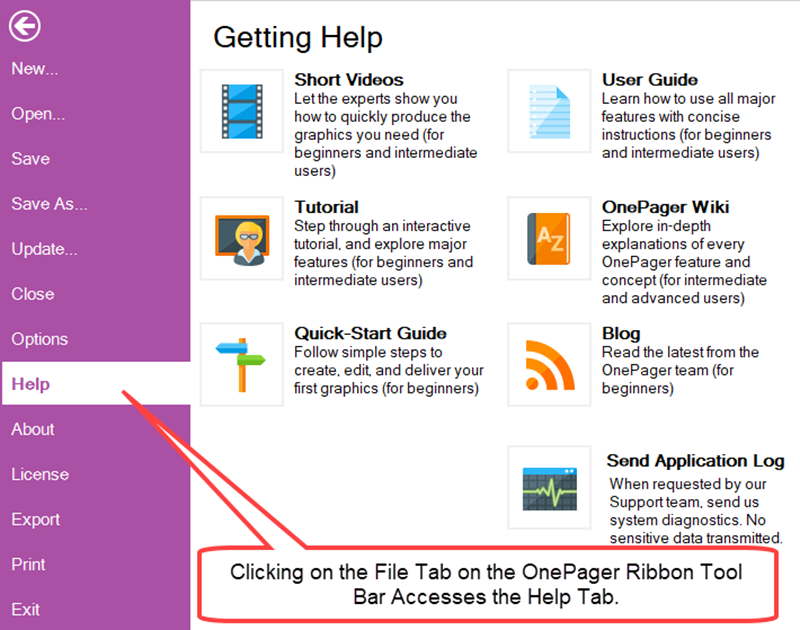
All File Page tabs are discussed in detail below.
File Page – New… Tab
Clicking the New… tab on the File page accesses the abbreviated OnePager choices form with the Please select a source file sub-section as shown below:

This action takes you back to the OnePager Home Ribbon Tool Bar tab where you can use the abbreviated OnePager choices form to load a different source plan or plans and thereby create a new chart from it.
File Page – Open… Tab
Clicking the Open… tab on the File page accesses a dropdown list with the most recent chart file names created. These chart file names are .tam files and selecting one of them launches another OnePager Chart Editor that displays the selected .tam file. This is illustrated below:
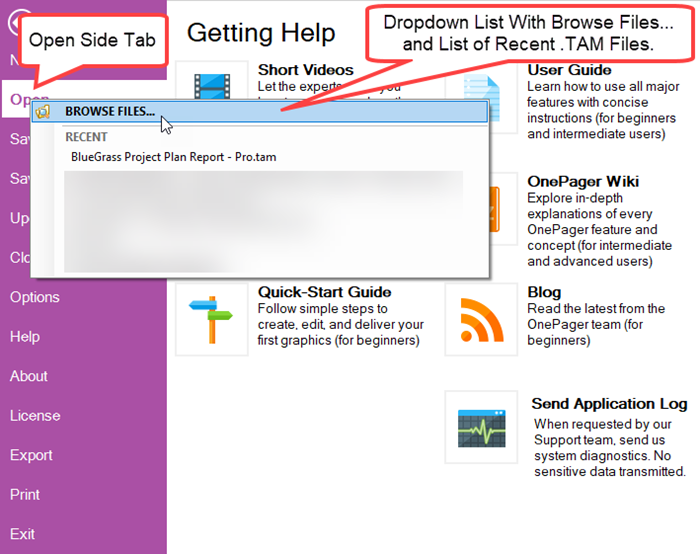
Clicking on the RECENT .tam file shown above accesses another instance of the Chart Editor from which you have access to the previously prepared chart for editing or other purposes as shown below:
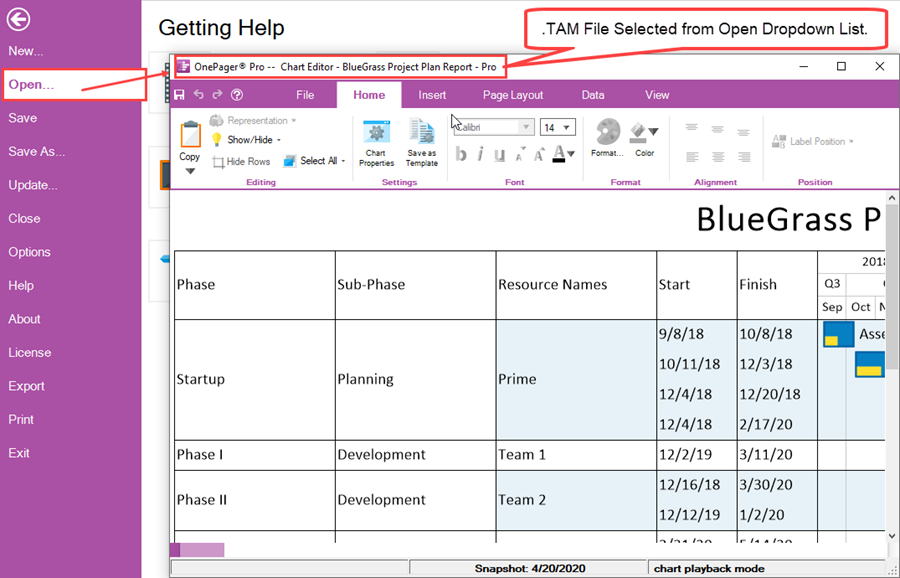
Note that the Get Help options remain visible after the Open tab is accessed.
The Open tab remains disabled until the newly opened .tam file is closed and you return to the original Chart Editor.
File Page – Save Tab
You can use the Save tab to save the current chart. Clicking the Save tab immediately takes you back to the OnePager Home Ribbon Tool Bar tab which is the Chart Editor and displays the Save as Chart (TAM) file form with the chart name inserted in the File name: window as shown below:
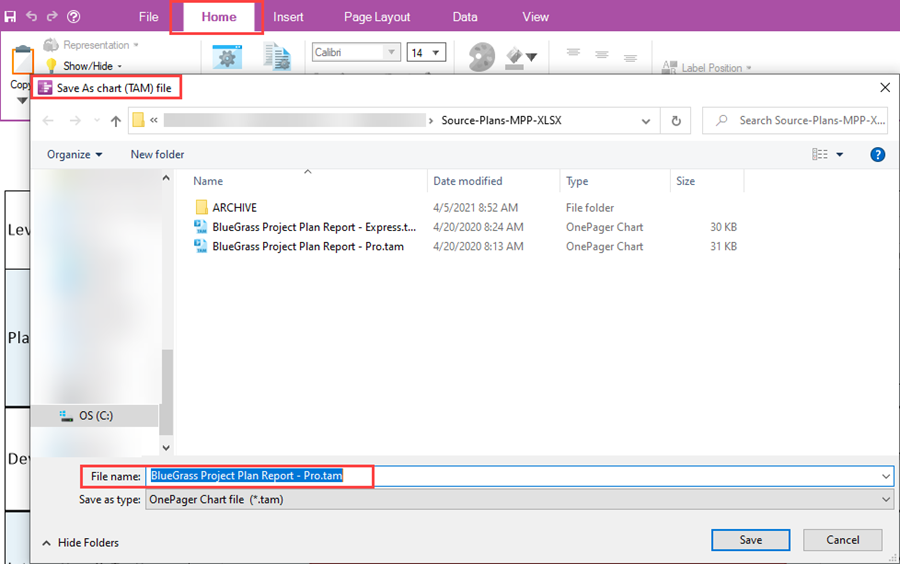
This form accesses the last location or folder where OnePager .tam files were last saved. At this point you can change the name of the file or the folder location where the file should be saved. Clicking the Save button saves the .tam file in the desired location and returns you to the Chart Editor at the OnePager Home Ribbon Tool Bar tab.
File Page – Save As… Tab
You can use the Save As… tab to save the current chart in a folder of your selection. Clicking the Save As… tab immediately accesses the Save as chart form shown below. The initial folder location is determined by the settings on the Options tab discussed in a subsequent sub-section below. For clarity, the Save as chart form is shown with the Options tab’s content in the background:

The intent above is to show that the initial folder accessed in the Save as chart form is determined by the setting in the Chart window shown above. At this point you can change the name of the file or the location where the .tam file should be saved. Clicking the Save button saves the .tam file in the desired location and returns you to original page where you clicked the Save As… tab.
AutoSave Checkbox
The AutoSave checkbox shown above turns the AutoSave feature ON and OFF. For more information on the AutoSave feature, please see the article at the link below:
| Automatic Saving of Charts Feature |
File Page – Update… Tab
You can use the Update… tab to perform an update of the current chart. Clicking the Update… tab accesses the update configuration of the OnePager choices form shown below where you can use the controls to perform an update of your current chart either to add a new snapshot or replace an existing snapshot:
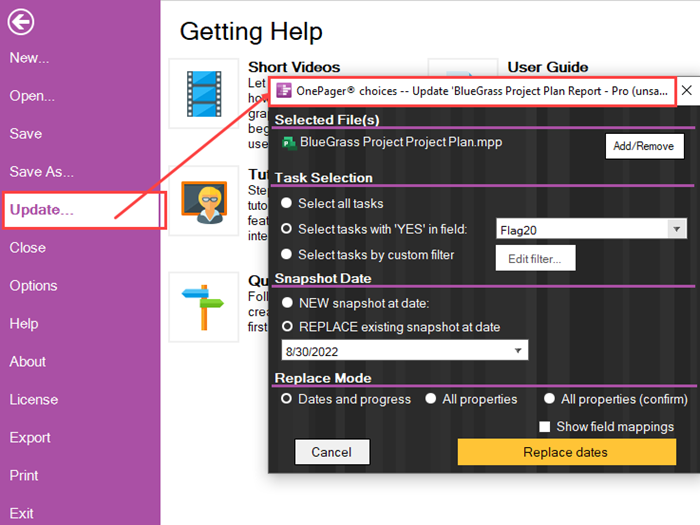
After performing the update, OnePager returns you to the OnePager Home Ribbon Tool Bar tab and the Chart Editor where the updated chart is displayed.
File Page – Close Tab
You can close the current chart in the Chart Editor by clicking the Close tab. Clicking the Close tab immediately displays a OnePager message form as shown below:
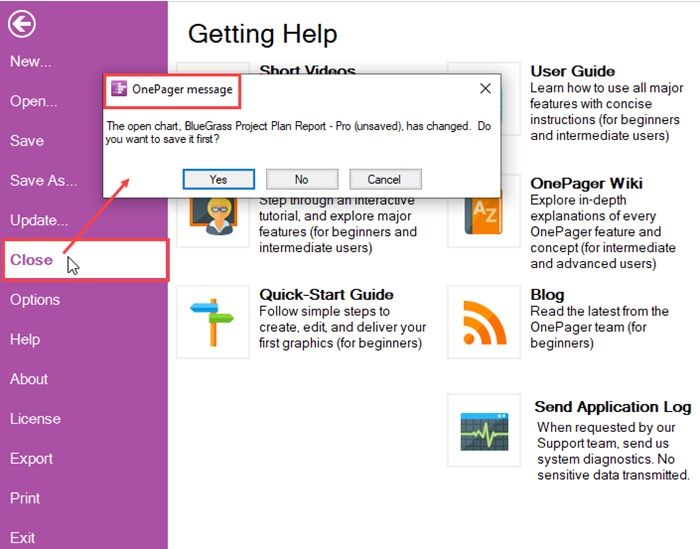
From the OnePager message form you have the option to click Yes, No, or Cancel.
- Clicking the Cancel button closes the OnePager message form and no further action by OnePager is taken.
- Clicking the No button also closes the OnePager message form and no further action is taken.
- When you click the Yes button in the OnePager Message form, OnePager access the Save As chart (TAM) file form as shown below:
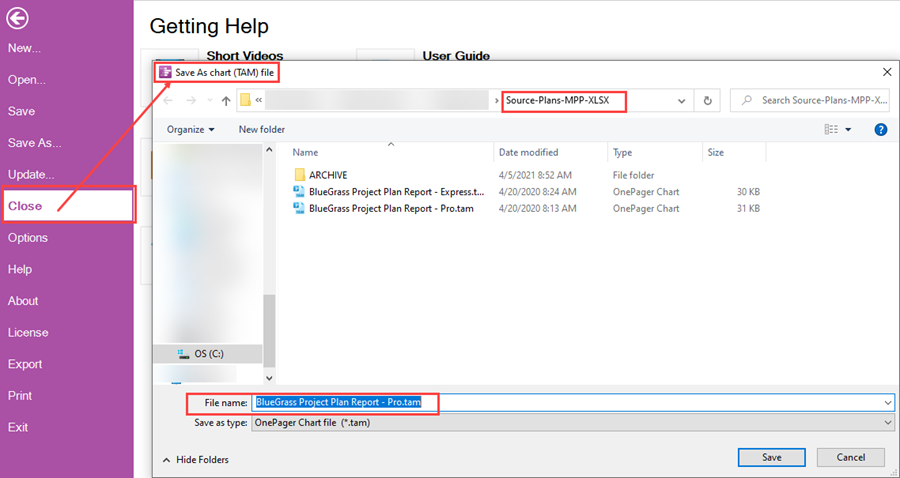
At this point you can change the name of the .tam file or the location where the .tam file is saved. Clicking the Save button on the form saves the .tam file in the desired location and returns you to original page where you clicked the Close tab. The action also closes the chart in the Chart Editor. When you return to the OnePager Home Ribbon Tool Bar tab, the Chart Editor screen looks like this minimized:
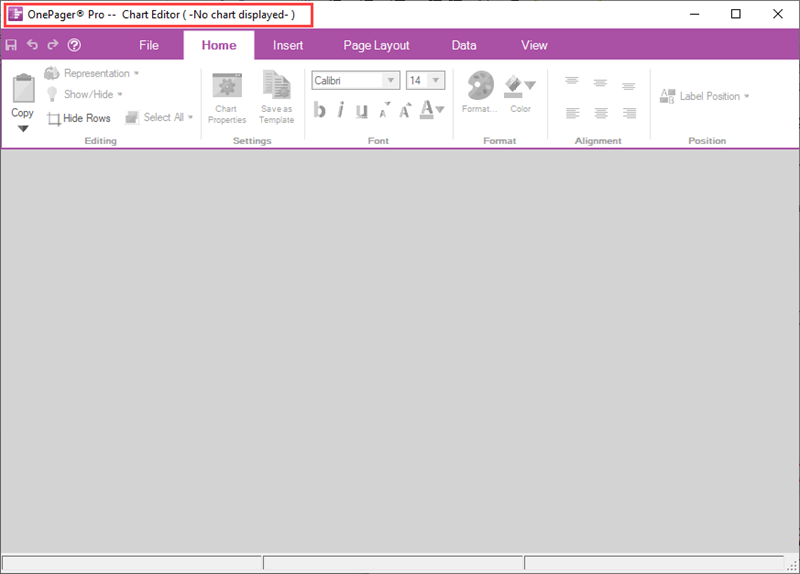
At this point you have the option to exit OnePager or to access another OnePager chart.
File Page – Options Tab
The Options Tab has three (3) purposes.
- First, it provides information on where OnePager stores and retrieves charts (i.e., .TAM files) and where OnePager stores and retrieves Template Properties forms, Color palettes, and Milestone symbols.
- Second, the Options tab provides the capability for you to change the locations of the four (4) elements previously described.
- And, third, the Template… button provides a way to access the current Template Properties form for the purpose of editing it or changing to a different Template Properties form. The Options tab is shown below:
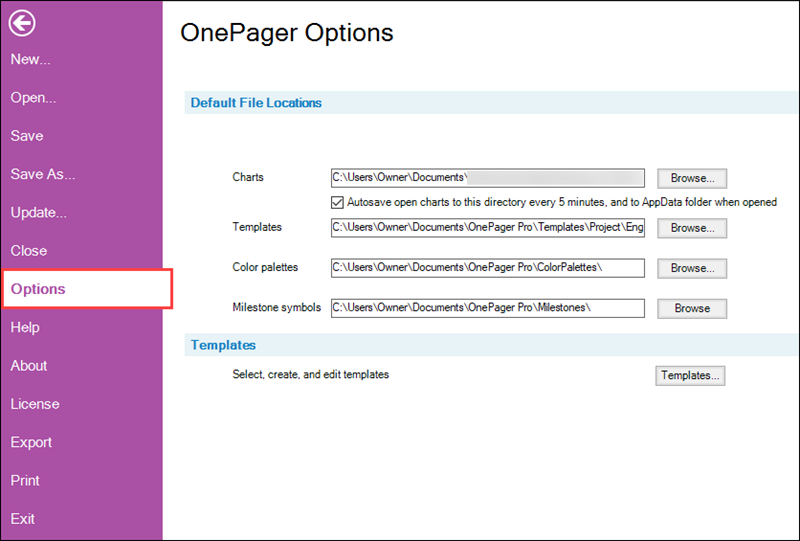
Clicking any of the four (4) Browse… buttons accesses the Browse for folder form where you can change where you access your .TAM files, Templates Properties forms, Color palettes, or Milestone symbols as shown below:
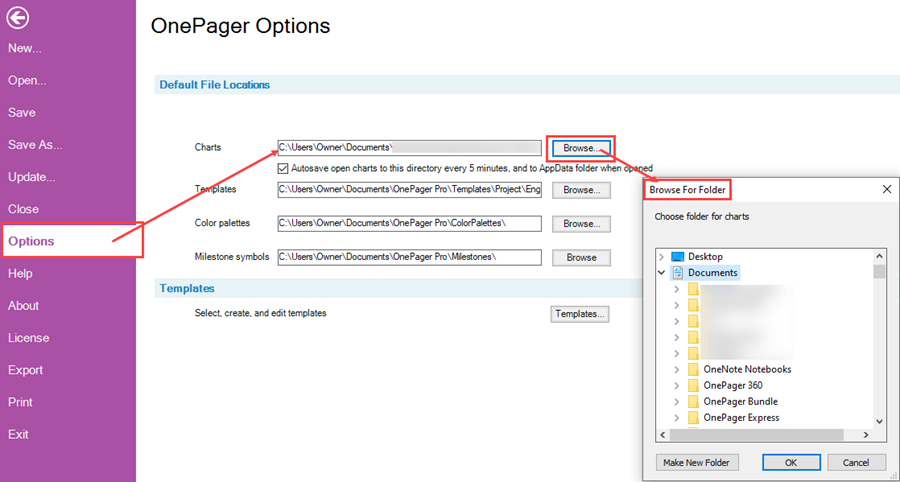
The Templates… button can be clicked to access the current Template Properties form for the purpose of making edits, creating a new Template Properties form, or changing to a different Template Properties form as shown here:
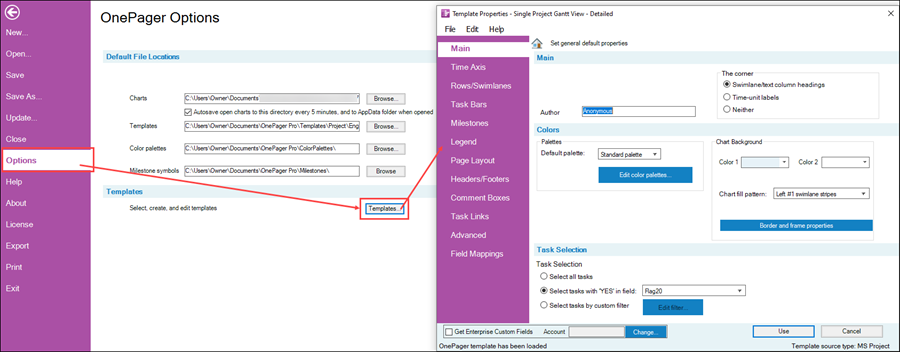
If OnePager already has a chart showing on the Chart Editor, changes made to the current Template Properties form have no impact on the chart. However, if the current Template Properties form is edited or change and saved, that edit or change Template Properties form may have an impact on the current chart if the chart is updated in the same session of the Chart Editor.
File Page – Help Tab
The Help Tab is the default tab OnePager presents when the OnePager Ribbon File Tool Bar tab is clicked. The Help tab has seven (7) buttons that provide access to different kinds of help tool available in OnePager as shown below:
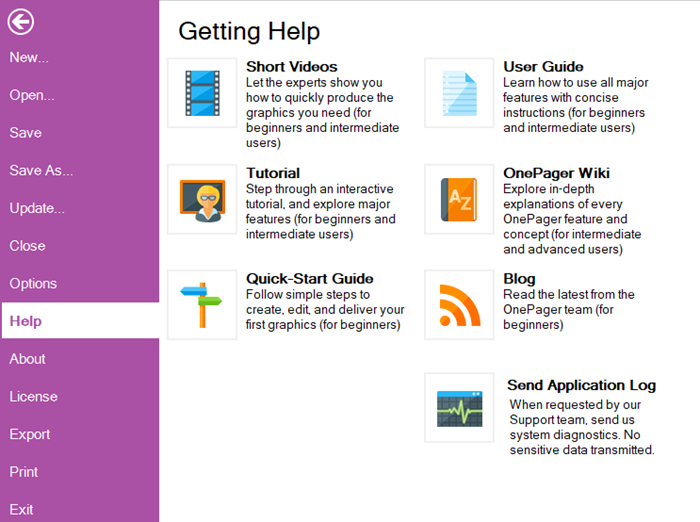
Each of these buttons is discussed below:
Show Videos Button
Clicking the Short Videos button launches a browser and takes you to the OnePager.com Video Tutorials page at:
| OnePager Video Tutorials |
The Show Video page has a list of available OnePager Videos you can use to introduce yourself to the features, functions, and capabilities of OnePager at the Basic, Intermediate, or Advanced levels.
Tutorial Button
Clicking the Tutorial button accesses OnePager’s built in Tutorial form which provides you access to the Tutorial for the specific product edition you are working with as shown below:
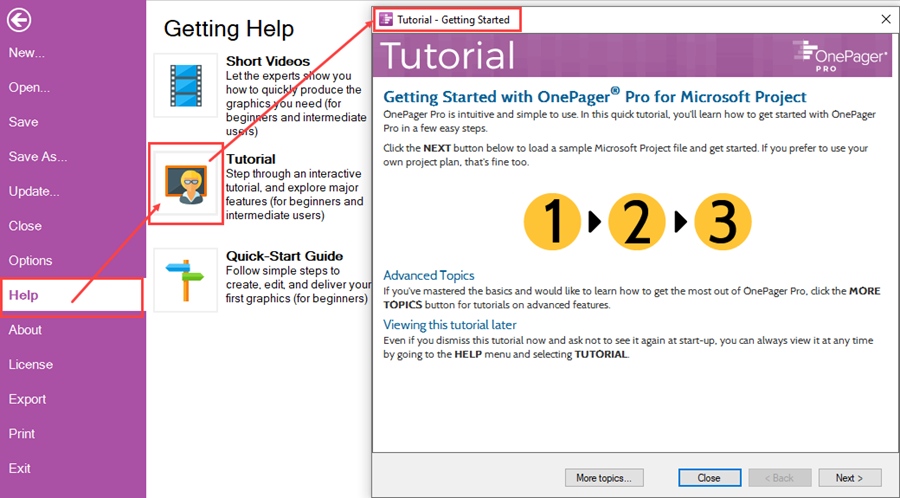
With the Tutorial form accessed, you can click on the Next > button to start the tutorial.
Quick Start Guide Button
Clicking the Quick Start Guide button launches an embedded browser PDF Reader with a short OnePager Quick Start Guide that is provided when you installed your edition of OnePager as shown below:
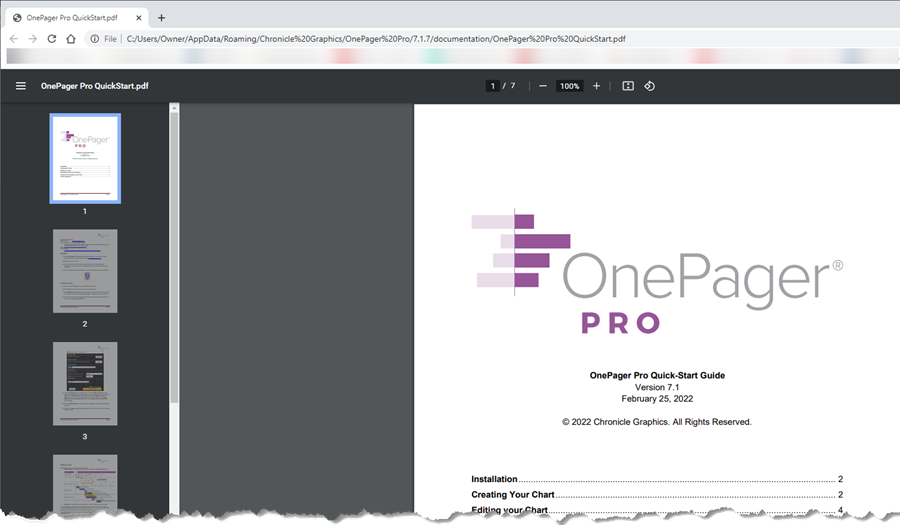
The OnePager Quick Start Guide document is typically sufficient to help you operate OnePager and create your first chart.
User Guide Button
Clicking the User Guide button launches an embedded browser PDF Reader with the longer OnePager User Guide that is provided when you installed your edition of OnePager as shown below:
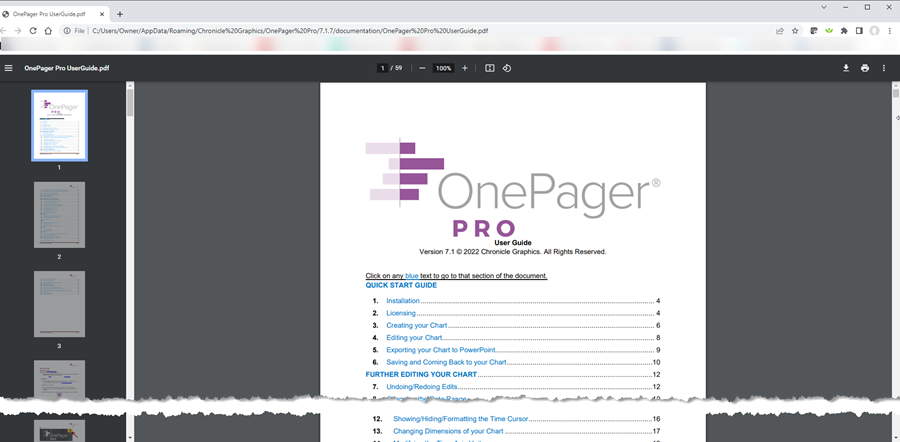
The OnePager User Guide document is a more detailed version of the OnePager Quick Start Guide document containing more detailed descriptions of available OnePager features, functions, and capabilities.
Wiki Button
Clicking the OnePager Wiki button launches a browser and takes you to the OnePager.com Wiki Title page at:
| OnePager Wiki |
The OnePager Wiki contains in depth detailed information on the use of all available versions and editions of OnePager. The Main Page of the OnePager Wiki looks like this:
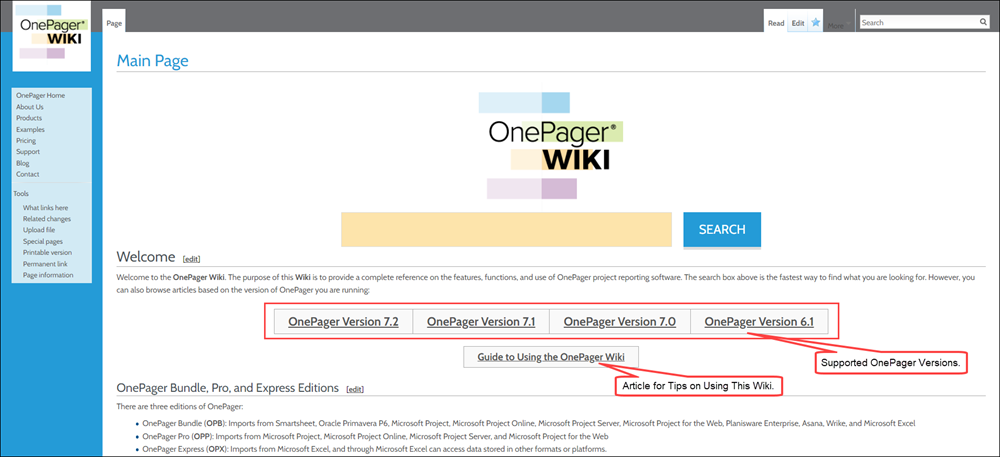
The OnePager Wiki provides in depth detailed information on using OnePager to its fullest capabilities back to Version Release 6.0. The Wiki contains detailed documentation for all supported source plan inputs to OnePager including Microsoft Project, Microsoft Project Online, Microsoft Project Server, Microsoft Excel, Smartsheet, Oracle Primavera P6., Project for the Web, Planisware Enterprise, Asana, and Wrike. The OnePager Wiki Main Page also has a button that provides access to an an article titled Guide to Using the OnePager Wiki which is recommended reading.
Blog Button
Clicking the Blog button launches a browser and takes you to the OnePager.com Blog page at:
| OnePager Blog |
The OnePager Blog contains informative articles on topics of interest to OnePager users including tips and tricks for getting the most out of OnePager to support your schedule conversations. The OnePager Bog Page looks like this:
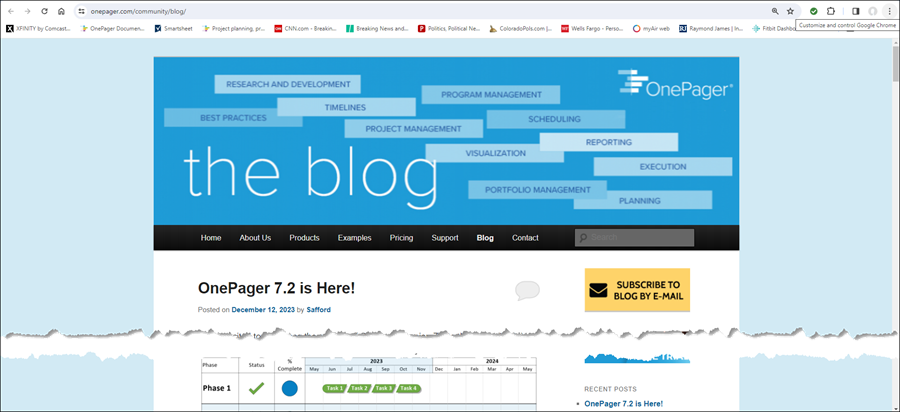
Send Application Log Button
The Send Application Log button is used when you have an issue with OnePager’s operation and you wish to pass the issue and your OnePager log file along to the OnePager Support Department. Additionally, the Support Department may ask you to email them your OnePager log file. Clicking the Send Application Log button accesses the Send Log Files form shown below:
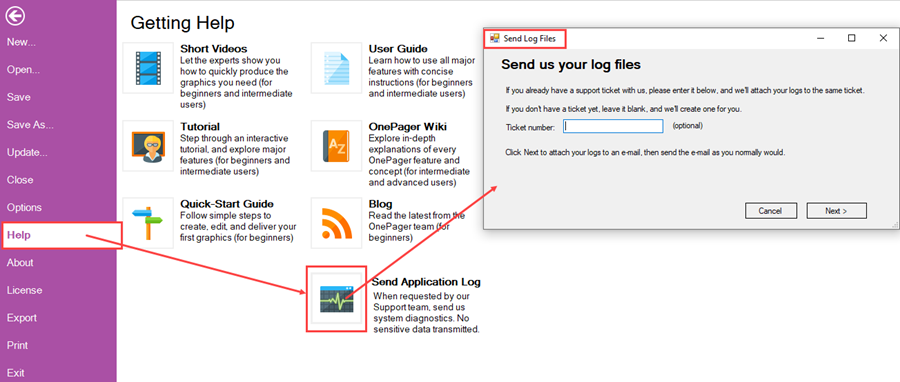
Follow the instructions in the Send Log Files form including entering a Ticket number, if applicable, and then click the Next > button. Clicking the Next > button launches your email application and attaches the current OnePager log file as shown in the illustration below where Microsoft Outlook is used as the email application:

After clicking the Next > button in the Send Log Files form, your email application creates a message addressed to support@onepager.com. Also, OnePager attaches the log file continuously created by OnePager on your computer. Please enter any further explanatory information in the body of the message to explain the issue and click the Send button. When OnePager’s Support Department receives the message they will analyze it and get corrective action or information back to you by return email.
File Page – About Tab
The About Tab is an informational tab that provides information about your OnePager installation and provides an option to provide Feedback to OnePager’s Support Department. The About tab page looks like this:
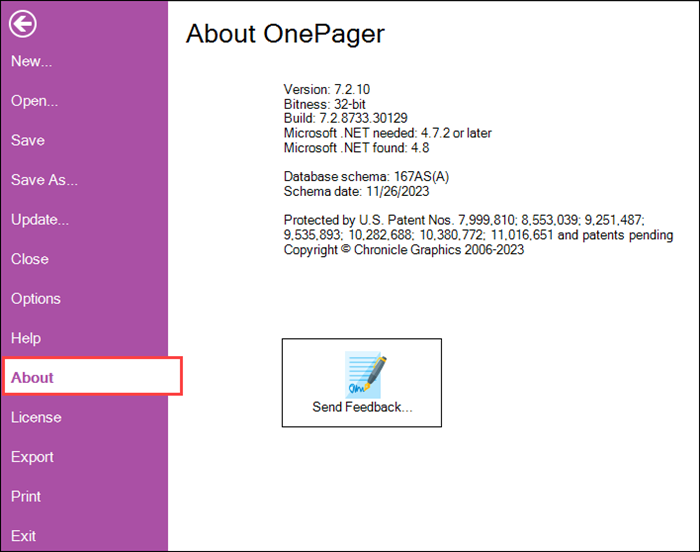
The Send Feedback… button, when clicked, takes you to the OnePager.com website at:
| OnePager Submit a Support Ticket |
The Submit Support Ticket page looks like this:
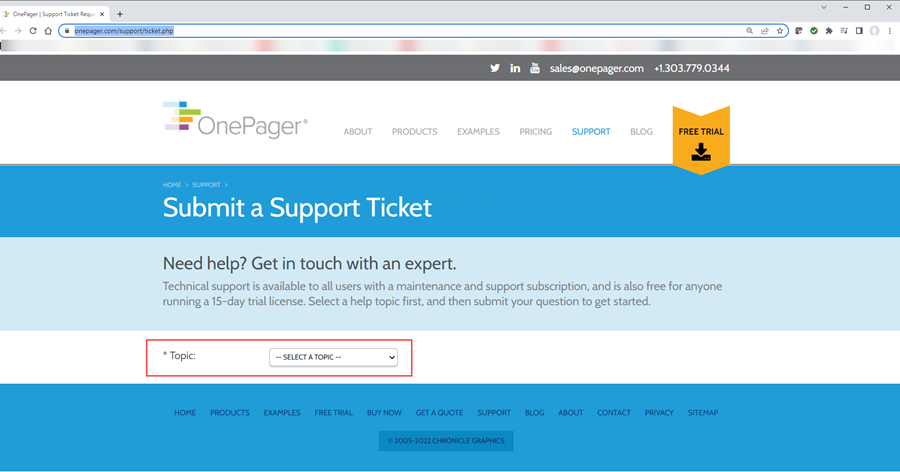
By selecting a Topic using the SELECT A TOPIC dropdown shown in the above illustration you are able to get access to suggested Frequently Asked Questions and communicate with OnePager’s Support Department to ask a specific question.
File Page – License Tab
The License Tab provides visibility of your License Key and a Get License Key button for you to obtain your License Key if you don’t have one. The License tab page looks like this:
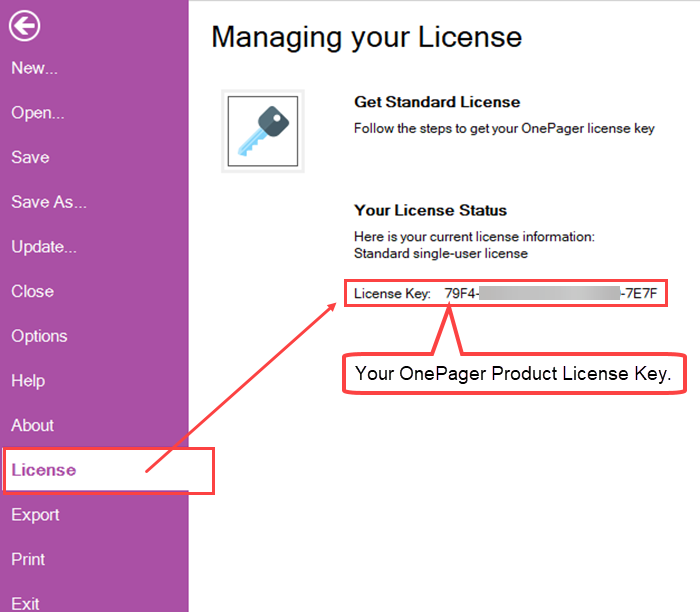
When you click the Get Standard License button, OnePager accesses the OnePager License form which can be used to request a OnePager License from the OnePager Support Department as shown below:
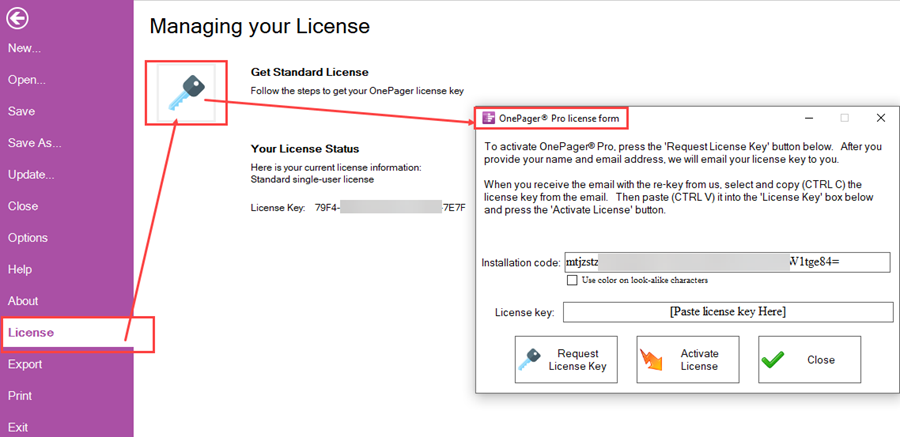
The Installation code: value is generated by your installation of the OnePager version on your computer. This Installation code, unique to you and your computer and is used by the OnePager Support Department to provide your paid License Key. The OnePager Support Department provides you paid License Key by return ''''email where you paste it into the License key: window and click the Activate License button to complete the transaction.
File Page – Export Tab
The Export Tab provides the capability to export OnePager charts (either single or multi-page) to four (4) types of output media. In OnePager, the term ”Export” refers to saving the chart for output media versus Copying the output media to the Windows Clipboard. The Export tab is shown here:
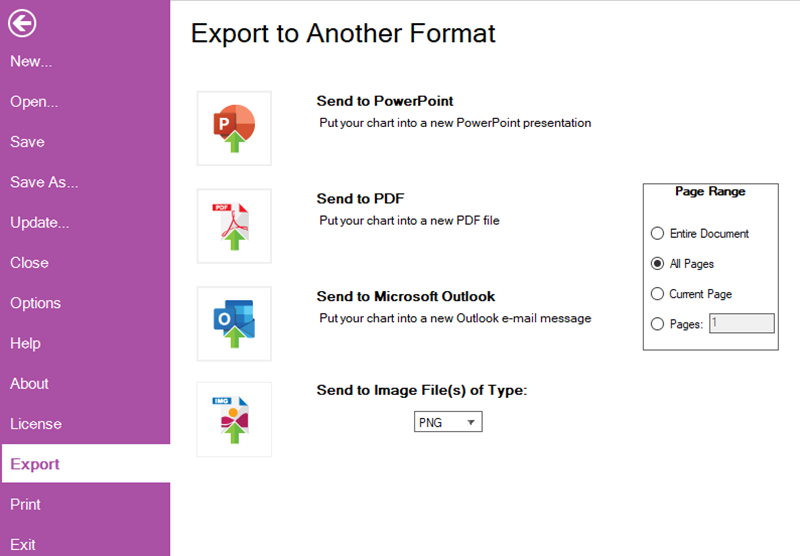
Before describing the four (4) buttons shown in the above form, please note that the Page Range option selection radio buttons on the right side of the illustration above are enabled for all four (4) buttons on the page. These radio buttons let you select to export the Entire Document, All Pages, the Current Page showing in the Chart Editor, or a specific Page Number.
Send to PowerPoint Button
When you click the Send to Power Point button, OnePager creates a Microsoft PowerPoint formatted output in the requested number of pages and accesses a Windows Save As form where the Microsoft PowerPoint formatted output can be saved as shown in the illustration that follows:

Once the chart or chart portion is exported (saved) a Microsoft PowerPoint presentation can be prepared with the data.
Send to PDF Button
When you click the Send to PDF button, OnePager creates a PDF formatted output in the requested number of pages and accesses a Windows Save As form where the PDF formatted output can be saved as shown in the illustration that follows:

Once the chart or chart portion is exported (saved) the PDF can be used as necessary as part of a PDF document.
For sending charts to PDF formatted files or to the Microsoft PowerPoint application, please see the article at:
| Sharing via Other Applications (e.g., PowerPoint) |
Send to Microsoft Outlook Button
When you click the Send to Microsoft Outlook button, OnePager creates a PNG formatted output of the chart in the requested number of pages and accesses your Microsoft Outlook application and attaches the PNG formatted output as an attachment to the Microsoft Outlook message form shown below:

Once the exported PNG formatted output is attached to the Microsoft Outlook message form, any accompanying text can be added to the message, it can be addressed, and sent.
Send to Image File(s) of Type: Button
The Send to Image File(s) of Type: button creates an image file of the current chart in the format determined by the selection of an image type format in the dropdown list immediately below the button title as shown here:
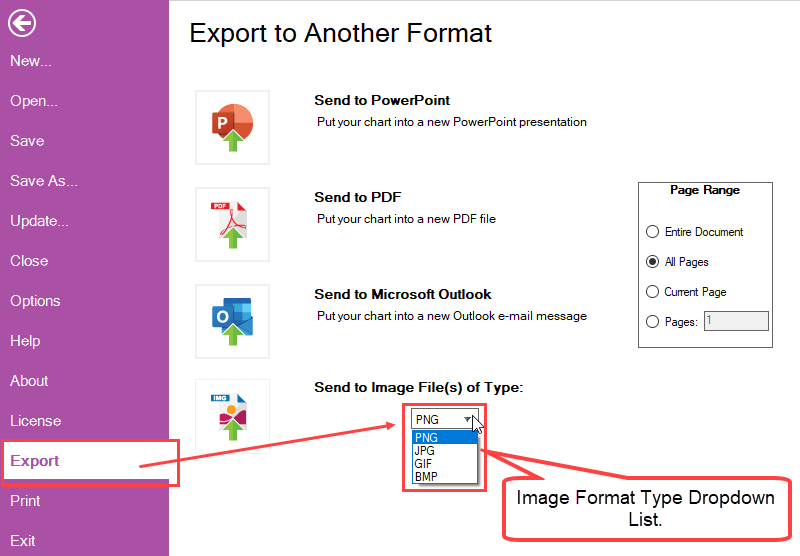
Before clicking the Send to Image File(s) of Type: button it is strongly recommended that you assure that the format type selection meets your needs.
Clicking the Send to Image File(s) of Type: button accesses a Save As form. This form, shown below, provides you the capability to determine where the created image in the format type selected is saved:

Once the chart or chart portion is exported (saved) the selected image format can be used as necessary as part of any document or presentation.
File Page – Print Tab
Clicking the Print Tab accesses a print preview page where the current chart is shown either in its one (1) page format or in a multi-page format as shown below:
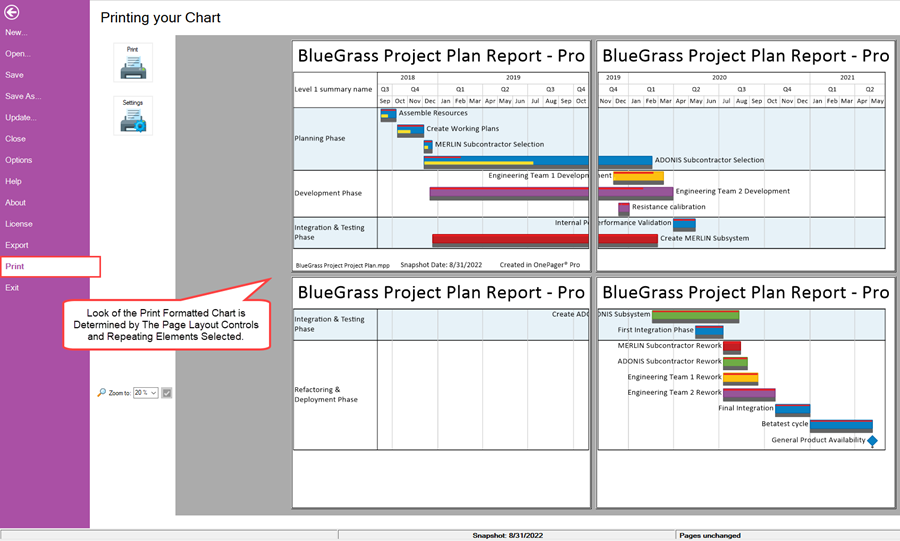
With the print version of the chart displayed, you have the option to adjust the printer settings by clicking the Settings button. Doing so assesses the current Chart Properties form’s Page Layout tab where you can make printer setting changes. You can also adjust the Zoom factor before printing by making a selection change using the Zoom to: control as shown below:
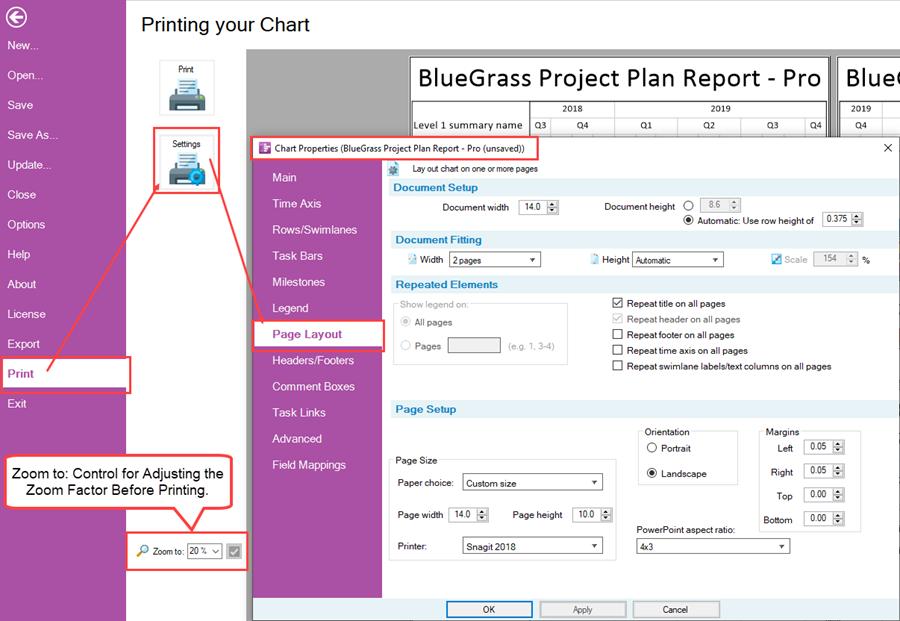
Clicking the Print button accesses your computer’s Windows Print form where final print controls can be adjusted and the document printed on the selected printer as shown here:
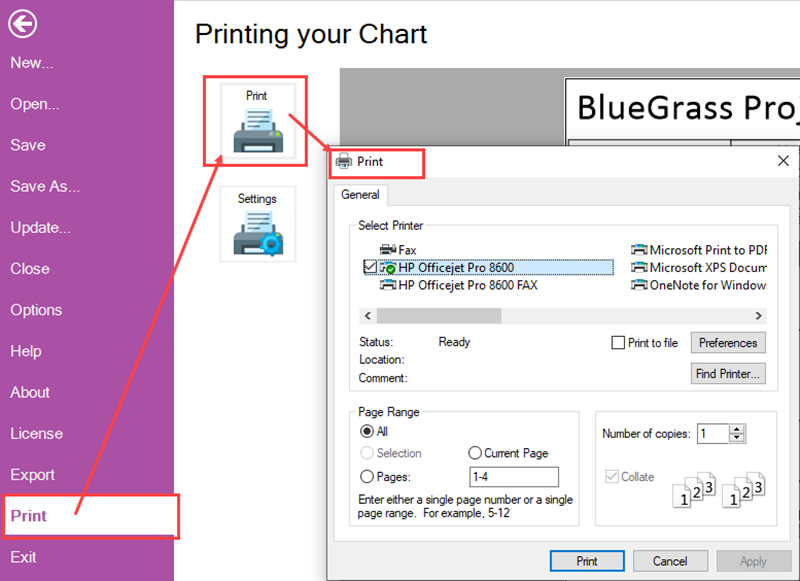
File Page – Exit Tab
The Exit Tab is used to exit the OnePager application. If there is a chart open in the Chart Editor, clicking the Exit tab accesses the OnePager message form shown below:
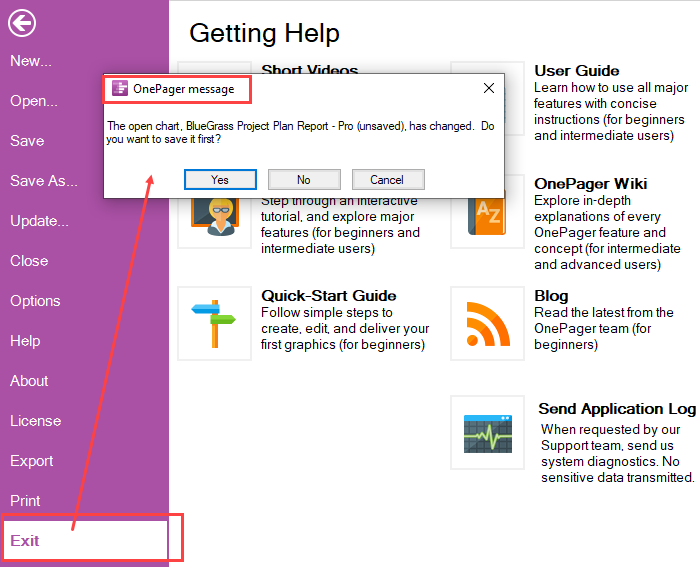
The displayed OnePager message form provides you with three (3) save options before the OnePager application is exited as discussed below:
- No – Clicking the No option immediately closes the OnePager application without saving the current chart.
- Cancel – Clicking the Cancel option closes the OnePager message from and returns you to the File Page.
- Yes – Clicking the Yes option accesses the OnePager Save As chart (TAM) file form where you can use these controls to save the current chart before exiting the OnePager application as shown here:
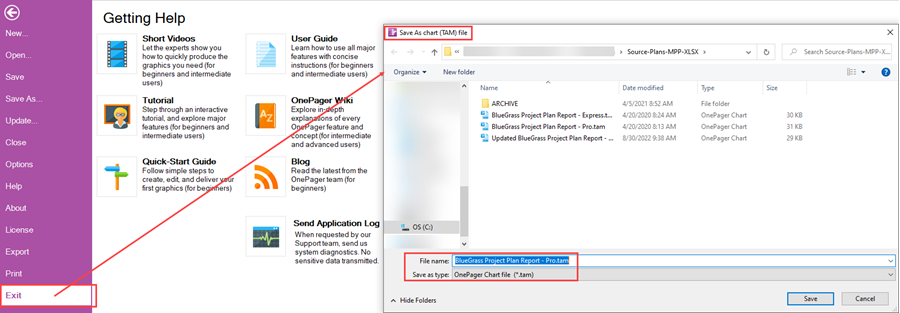
Related Links
| OnePager Video Tutorials | OnePager Wiki |
| OnePager Blog | OnePager Submit a Support Ticket |
(4.0.2.2.11-72)